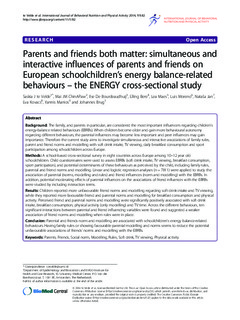| dc.contributor.author | te Velde, Saskia J. | |
| dc.contributor.author | Chinapaw, Mai JM | |
| dc.contributor.author | De Bourdeaudhuij, Ilse | |
| dc.contributor.author | Bere, Elling | |
| dc.contributor.author | Maes, Lea | |
| dc.contributor.author | Moreno, Luis | |
| dc.contributor.author | Jan, Nataša | |
| dc.contributor.author | Kovacs, Eva | |
| dc.contributor.author | Manios, Yannis | |
| dc.contributor.author | Brug, Johannes | |
| dc.date.accessioned | 2014-09-12T09:06:01Z | |
| dc.date.available | 2014-09-12T09:06:01Z | |
| dc.date.issued | 2014 | |
| dc.identifier.citation | Te Velde, S., Chinapaw, M., De Bourdeaudhuij, I., Bere, E., Maes, L., Moreno, L., . . . Brug, J. (2014). Parents and friends both matter: simultaneous and interactive influences of parents and friends on European schoolchildren's energy balance-related behaviours - the ENERGY cross-sectional study. International Journal of Behavioral Nutrition and Physical Activity, 11(1), 82. doi: 10.1186/1479-5868-11-82 | nb_NO |
| dc.identifier.issn | 1479-5868 | |
| dc.identifier.uri | http://hdl.handle.net/11250/219624 | |
| dc.description | Published version of an article from the journal:International Journal of Behavioral Nutrition and Physical Activity. Also available from the publisher: http://dx.doi.org/10.1186/1479-5868-11-82 | nb_NO |
| dc.description.abstract | Background: The family, and parents in particular, are considered the most important influencers regarding children’s
energy-balance related behaviours (EBRBs). When children become older and gain more behavioural autonomy
regarding different behaviours, the parental influences may become less important and peer influences may gain
importance. Therefore the current study aims to investigate simultaneous and interactive associations of family rules,
parent and friend norms and modelling with soft drink intake, TV viewing, daily breakfast consumption and sport
participation among schoolchildren across Europe.
Methods: A school-based cross-sectional survey in eight countries across Europe among 10–12 year old
schoolchildren. Child questionnaires were used to assess EBRBs (soft drink intake, TV viewing, breakfast consumption,
sport participation), and potential determinants of these behaviours as perceived by the child, including family rules,
parental and friend norms and modelling. Linear and logistic regression analyses (n = 7811) were applied to study the
association of parental (norms, modelling and rules) and friend influences (norm and modelling) with the EBRBs. In
addition, potential moderating effects of parental influences on the associations of friend influences with the EBRBs
were studied by including interaction terms.
Results: Children reported more unfavourable friend norms and modelling regarding soft drink intake and TV viewing,
while they reported more favourable friend and parental norms and modelling for breakfast consumption and physical
activity. Perceived friend and parental norms and modelling were significantly positively associated with soft drink
intake, breakfast consumption, physical activity (only modelling) and TV time. Across the different behaviours, ten
significant interactions between parental and friend influencing variables were found and suggested a weaker
association of friend norms and modelling when rules were in place.
Conclusion: Parental and friends norm and modelling are associated with schoolchildren’s energy balance-related
behaviours. Having family rules or showing favourable parental modelling and norms seems to reduce the potential
unfavourable associations of friends’ norms and modelling with the EBRBs. | nb_NO |
| dc.language.iso | eng | nb_NO |
| dc.publisher | Biomedcentral | nb_NO |
| dc.rights | Navngivelse 3.0 Norge | * |
| dc.rights.uri | http://creativecommons.org/licenses/by/3.0/no/ | * |
| dc.title | Parents and friends both matter: simultaneous and interactive influences of parents and friends on European schoolchildren's energy balance-related behaviours - the ENERGY cross-sectional study | nb_NO |
| dc.type | Journal article | nb_NO |
| dc.type | Peer reviewed | nb_NO |
| dc.subject.nsi | VDP::Medical disciplines: 700::Health sciences: 800::Preventive medicine: 804 | nb_NO |
| dc.subject.nsi | VDP::Medical disciplines: 700::Health sciences: 800::Nutrition: 811 | nb_NO |
| dc.source.pagenumber | 17 p. | nb_NO |
| dc.source.volume | 11 | nb_NO |
| dc.source.journal | International Journal of Behavioral Nutrition and Physical Activity | nb_NO |
| dc.source.issue | 1 | nb_NO |
| dc.identifier.doi | 10.1186/1479-5868-11-82 | |

